#sámi history
Explore tagged Tumblr posts
Text
Sámi artist Mari Boine joiking the village Máze.


[ID: 1: Sámi activists in gáktis (traditional clothing) holding a banner that says “we came here first” in norwegian. A banner in the background says “we will NOT move”. 2: sámi man in gákti standing with his fist raised in front of big stones that have the word “let the river live” painted on them]
Joik is a type of traditional sámi singing that’s meant to evoke/express a person, animal or place through rhythm, sounds and energy. You don’t joik about someone, you joik them. Joik is mostly sounds, and often have no lyrics or short lyrics. “Máze” has lyrics calling Máze beautiful and saying “Under water they would put Máze church, Máze school”, which is referring to the Alta conflict in the 1970s and 80s.
Máze is a small village on the norwegian side of the borders in Sápmi. Around 98% of the population is sámi. In the late 1960s, the Norwegian government announced plans to build a hydroelectric power plant and dam in the Alta river, which would have huge consequences for sámi reindeer herding and fishing in the area, preventing sámi people from continuing to practice their traditional way of life. The earlier plans for the dam would have put Máze under water, displacing all the people living there and destroying a village that has existed for hundreds of years. After resistance from sámi activists, the plans were altered in 1973 so that Máze would survive.
Sámi people fought against the construction of the power plant for years, with protests, peaceful civil disobedience (like chaining themselves and creating blockades around the site), and a hunger strike where they slept in lávvus in front of the norwegian parliament in 1979, and a second hunger strike in 1981. 10% of the norwegian police force was sent to the construction area and there was talk of sending the military to assist the police, but this was stopped by the minister of defense at the time. several hundreds of people were removed by force from protests and arrested.
The Alta hydroelectric power plant was finished in 1987 and is still in operation. This is one of the most famous examples of Norway’s green colonialism in Sápmi, but it’s also one of the biggest examples of Sámi spirit and resistance. Máze continues to exist, more than 50 years later. Sámi people are still here and we’re still fighting for our right to continue our traditional lifestyles and culture, for example with the large civil disobedience actions in 2023 over the Fosen case.
Čájet Sámi Vuoiŋŋa! show sámi spirit! ❤️💚💛💙
340 notes
·
View notes
Text
i recently have become more active in indigenous american activism, but as i live in finland right now and not turtle island i want to get to know more about sámi people. do any sámi, finnish, or otherwise friends here have a good recs on where is a good place to start?
#ill be hitting up the library soon about it#perhaps this weekend#and ill ask classmates too of course#sámi#sámi history#sámi contemporary history
3 notes
·
View notes
Text
ELSA LAULA RENBURG // ACTIVIST
“She was a Southern Sámi activist and politician. In 1904, Renberg wrote and published a 30-page pamphlet in Swedish entitled Infor lif eller död? Sanningsord i de Lappska förhållandena (Do we face life or death? Words of truth about the Lappish situation) making her the first Sámi woman to have her writings published. This work discussed several issues that were facing the Sámi, such as their education system, their right to vote, and their right to own land. In 1904 she founded the South Sámi Fatmomakka Association, which was the first Sámi activist organisation. Its aim was to combat issues surrounding increasing state colonization and settler presence on Sámi lands, and to resolve local land conflicts, as well as improve the societal, economic, and political position of the Sámi. She was also the chair of the organizing committee of the first Sámi Assembly of 1917 in Trondheim.”

0 notes
Text
youtube
Unshaming my indigenous heritage | Mari Boine
Mari Boine grew up in a Sámi family in the North of Norway, where she was taught to be ashamed of her heritage and the close relation to nature. Growing up she found the opposite to be true, and turned the realisation into a life long musical career. Mari is a singer, musician and songwriter from Sápmi, Norway. Her music is infused with Sami roots (joik) in combination with jazz, rock and electronic sounds. Mari Boine has been one of the most outspoken and important representatives of the Sámi culture. As an artist and activist, she has worked tirelessly for the recognition and preservation of the indigenous Sámi culture and for the protection of Mother Earth among other causes. This talk was given at a TEDx event using the TED conference format but independently organized by a local community.
#Sámi#Sápmi#Mari Boine#Sámi heritage and culture#indigenous history#norway#mother earth#healing#TEDx talk#music#joik#important#video#Youtube
20 notes
·
View notes
Text
Unknown ancient languages in the area of modern day Finland
Before the arrival of Western Uralic languages, which eventually developed into the Sámi languages and Finnish, there were already earlier languages being spoken in the area of modern day Finland. These ancient languages are completely unknown to us; after all, their cultures did not write. However, some names and words from those languages still live on as they were loaned into Sámi and Finnish and are still in use.
The prevalence of these loan words is higher in Sámi than in Finnish: as much as third of the words in Sámi languages are of unknown origin. The Sámi linguist Ante Aikio has been able to find at least two different ancient languages which the Sámi languages loaned words from in the area. The southern language he has dubbed Paleo-Lakelandic, the northern one Paleo-Laplandic. Before the arrival of Western Uralic languages, there had already been human settlements in Finland for nearly 10 millenia.
The first wave of Western Uralic languages came from the group whose Western Uralic dialect eventually developed into the Proto-Sámic language. As established, they loaned a lot of words from these ancient languages in Finland. The Finnish language has a more complicated origin, geographically. I'll write it with a smaller font as it is kind of off-topic but if you're interested:
The sister of Proto-Sámic is Proto-Baltic Finnic, which was born when Western Uralic dialects west of modern day Central Russia split into Proto-Finnic and Mordvinic lanugages. At this state, they loaned words from the ancient language of the Comb-Ceramic culture. Some of Proto-Finnics started living together with the Indo-European Baltic speakers, resulting in the birth of the Proto-Baltic Finnic language. This community was bilingual; possibly even for a thousand years. This explains the massive amount of Baltic loan words in Finnish. This community also loaned words from the earlier languages of the Baltic (before the arrival of Baltic or Proto-Baltic Finnic languages), mainly names of different kinds of fish.
After this, the Proto-Baltic Finnic language spread over the gulf to Southern Finland and encountered ancient languages of Finland it borrowed words from. Eventually, it encountered (and mixed with) Proto-Sámic. This mixing resulted in the birth of Finnish (or rather, its different dialects) as its separate language. Similarly, in the more northern areas, the Proto-Sámic language split into the different Sámi languages of modern day.
This process was slow. In the 17th century, there were still the last speakers of a Sámi language in Kainuu, for example. However, they mixed with and switched to Finnish centuries ago. And similarly, there were possibly still pre-Sámi languages spoken in the north of Fennoscandia during the Medieval times. They switched to speaking Sámi, much like Sámi-speakers in more southern areas switched to speaking Finnish.
Some words (note these are educated guesses):
The words "kontio" (bear) and "nuotio" (campfire) possibly came to Finnish through Sámi, originally from Old Lakelandic. Also through Sámi, from Old Laplandic, are the words "mursu" (walrus), "norppa" (ringed seal), and "kiiruna" (rock ptarmigan).
Some words that were loaned from ancient languages directly to Proto-Finnish without the Sámi middleman include "niemi" (small peninsula), "saari" (island), and "vuori" (mountain, hill).
Many place names in Finland have names that seem to originate from ancient languages as well, such as Saimaa, Inari and Päijänne.
The text is translated and condensed from Ennen suomea ja saamea Suomen alueella puhuttiin lukuisia kadonneita kieliä — kielitieteilijät ovat löytäneet niistä jäänteitä (Prior to Finnish and Sámi, multiple lost languages were spoken in the area of Finland — linguists have found relicts of them).
19 notes
·
View notes
Text
youtube
3 notes
·
View notes
Text
Hear the role Norway’s indigenous Sámi people played in the Vardø witch trials in “The Perpetual Flame” at enchantedpodcast.net or wherever you listen to podcasts.
#magic#magick#witchcraft#sorcery#history#podcast#early modern#witch trials#enchantedpodcast#norway#sámi#vardø#witchtrials#history podcast
3 notes
·
View notes
Text
"I was reminded of this video, one of my favorite any topic ever, of when the Sámi confronted the Nazis of the NMR from Sweden which had come to the indigenous people's Jåhkåmåhke Márnána/Jokkmokk Market in the Sweden-held part of Sápmi in 2018, until the Nazi scum gave up and went away."
"NO racists on OUR streets! NO nazis on OUR streets!"










#video#161#1312#sámi#nazis#nmr#sweden#indigenous#Jåhkåmåhke Márnána#Jokkmokk#Sápmi#2018#history#nazisploitation#nazigate#sacha baron cohen accuses tiktok of ‘biggest antisemitism movement since the nazis’#nazi#neonazis#neofascism#no racists#no fascists#class war#antinazi#antifascist#antifaschistische aktion#antiauthoritarian#anarchism#ausgov#politas#auspol
6 notes
·
View notes
Text
The Controversy of Uralic Peoples as Mongoloids


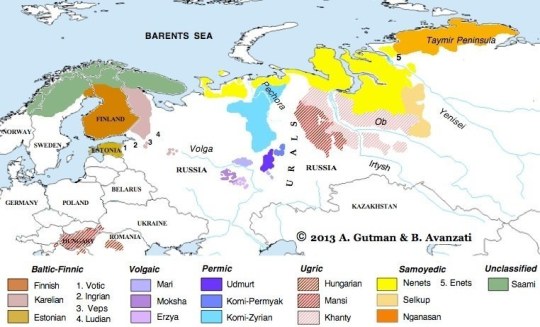

During the age of European nationalism, Finns, Hungarians, and Estonians have often had the concept of their Whiteness challenged. Some individuals have even gone out of their way to classify these three collectives as a part of the Mongoloid (East Asian) race. The strongest evidence for this claim had to do with linguistics. In the 21st century, many individuals only recognize language to be a fluid construct that has no indication of race. However, Europeans of the late 19th and early 20th century perceived language as an ethno-racial marker.
Some Western Chauvinists theorized that their shared identity of whiteness was partly ingrained in their common linguistic heritage. A broad language family identified as "Indo-European" is what loosely bound the white race together. The Finnish and Estonian tongues, however, are derived from the "Finno-Ugric" or "Uralic" language family. Because of this discrepancy, the Uralic peoples were considered Orientalized by their lack of linguistic kinship. In addition to a difference in language, certain Uralic populations also possessed physical features similar to that of East Asians. Most notably, ethnic groups like the Khanty and Mansi have pronounced epicanthic folds and maintain distinct linguistic ties with the Hungarians. These linguistic and phenotypic attributes indicated that, although the Finns, Hungarians, and Estonians appeared to be white Europeans, they were, in actuality, descendants of the Mongoloid race. These racial designations were not merely trivial ideological conflicts either. We see its impacts demonstrated when, in the United States, early Finnish immigrants were not considered white. In their book, Peter Kivisto and Johanna Leinonen note how a Finnish gentleman was denied American citizenship due to his Mongoloid origins.
This condescending view of the Finns was even shared by their fellow kin from Central Europe, the Hungarians. But why? Why would the Hungarians, a fellow Uralic-speaking people, deny any sort of linguistic/lineage tie with the Finns? This rejection is rooted in several factors tied to race, culture, and politics. In terms of politics, Hungarians have often tried to ease themselves into the sphere of pan-Turkism. This was especially prominent during the era of European nationalism when pan-Slavism was perceived as a threat to Hungary. In a reaction to Pan-Slavism, the Hungarians have often hearkened to their steppe ancestry as proof to be included as a part of a Turkic union. In addition to political factors, Hungarian history has instilled a strong sense of pride in their descent from hardened steppe warriors. The Hungarian nationalists envision themselves as the perfect syncretism of equestrian valor and . However, this romantic imagery is removed by asserting that Hungarians are related to the Uralic people. Uralic people, who were not steppe warriors, but lowly fishermen from the baron reaches of northern Europe.
The Nordicists sought to reinforce Hungary's shared origin with the Finns by emphasizing their cranial similarities. In his work Intra-Nordic Differences, Suvi Keskinen writes:
"Anders Retzius, Professor of Anatomy and Physiology,
developed a skull index to investigate “longskulls” and “shortskulls,”
coming to the conclusion that the Finns, the Sámi, and Hungarians
were to be placed among the Turanian type, understood as of Asian
origin"
Finland's history of being colonized by Sweden only added to the narrative that Uralic people were naturally meant to exist as subjugated people. This was in no way appealing to the Hungarians who sought independence from the Austrian Empire. This degrading portrayal of Finns as a subjugated and primitive race caused Hungarians to distance themselves from any sort of shared identity. In the book Languages and Publics, by Susan Gal and Kathryn Woolard, the authors note that a certain linguist was disgusted at the notion of having any sort of ancestral lineage to the Finns. In contemporary times, however, Hungarians have largely come to accept their place as members of the Uralic language family. Though others may stress the possibility of Turkic roots, one cannot deny the distant Siberian influence present across all Uralic peoples.
As the era of nationalism waned, the focus on race and ethnicity also diminished. The tumultuous aftermath of World War 2 prompted European nations to reconsider their relationships with neighboring countries. This shifting landscape gradually relieved the burden on Finns, Hungarians, and Estonians to constantly affirm their place within the Western sphere. The post-war period brought a nuanced perspective, allowing these nations a respite from the need to continually assert their Western identities.
Book Sources:
Kivisto, Peter, and Johanna Leinonen. “Representing Race: Ongoing Uncertainties about Finnish American Racial Identity.” Journal of American Ethnic History 31, no. 1 (2011): 11–33. https://doi.org/10.5406/jamerethnhist.31.1.0011.
Map Sources:
Morton, Samuel George. 1839. Crania americana or, A comparative view of the skulls of various aboriginal nations of North and South America. To which is prefixed an essay on the varieties of the human species. Illustrated byseventy-eight plates and a colored map., Philadelphia : J. Dobson; London : Simpkin.Marshall & co.
Map of human races (Meyers Konversations-Lexikon, 1885–1890)
#finland#finnish#magyar#hungarian#history#anthropology#nordic#uralic#linguistics#america#united states#sámi#europe#western civilization#maps#turkic#nomad#mongolia#asian#mongoloid#national identity#country#estonia#khanty#finno ugric#carpathians#ethnicity#hungary#european#suomi
5 notes
·
View notes
Text
Ædnan by Linnea Axelsson: “Crystalline prose that reads like poetry and myth at once.”
Beautiful, unique and tragic, I've never read a story quite like Ædnan and I cannot stop thinking about it.
Ædnan is a lyrical story of the Sámi people. It’s told by five generations of the same family covering a hundred years of their tragic history, their losing struggle to continue their nomadic lifestyle. In Northern Sámi, the word Ædnan means the land, the earth, and my mother. Axelsson’s family epic begins in the early spring of 1913 with Ber-Joná expressing his love for their rangeland that runs…
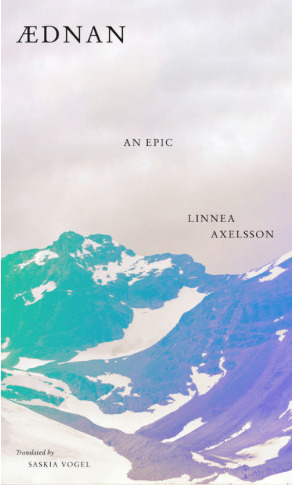
View On WordPress
0 notes
Text
ELLA MARIE HÆTTA ISAKSEN // MUSICIAN
“She is a Sami musician from Tana, Norway. In 2016 she won the Sámi Grand Prix with her original song Luoddaearru, and in 2017 she won Liet International with the same song. In 2017 Isaksen started the band ISÁK. In October 2018 she won the NRK-show Stjernekamp. She was the county leader in the environmental protection organization Natur og Ungdom from January 2015 until January 2016. She continued her work in the organization until she was hired as a campaign secretary in Natur og Ungdom in the autumn of 2017. Furthermore, she was elected to the central board of the organization in January 2018, where she sat for six months, until she chose to focus on music in the summer of 2018.”


3 notes
·
View notes
Text
For lundehunds I think it's a bit of both. Our historical breeds are seen as part of our cultural heritage and identity, and the initial preservation efforts of a lot of them (buhunds, fjord horses and livestock breeds in particular) coincided with greater movements of national romanticism - Norway was under Danish rule until 1814 and only gained independence from Sweden in 1905. Most of the work around standardization and stud books happened in the latter half of 1800. This movement missed out on the Lundehund, which only really started picking up speed after their near-wipeout from distemper in the 1940s, but I think still says a bit about why we're so protective of our breeds.
But ofc the Lundehund now has become sort of the pinnacle of Norwegian preservation breeding. Everyone knows what a Lundehund is, because they were a cornestone for a very specific way of life, but also because they're objectively fucking bizarre.
Utilization: By his anatomical peculiarities this dog is predestinated to puffin-hunting on the steep rocks around the fjords and along the shore.
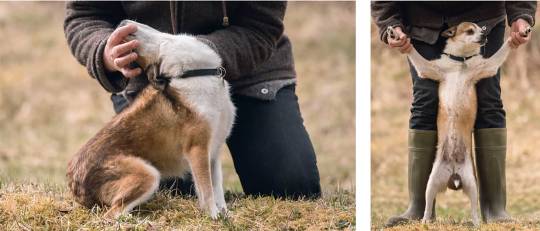
The standard:
Neck: Clean-cut, of medium length, quite strong with a relatively well furnished collar.
Compendium comment:
The head is carried relatively low. The two last vertebrae (atlas/apsis) are shaped so that the dog can bend backwards so that the head touches the back. To do so is vital when turning in the narrow burrows. NB! This should NEVER be demonstrated the ring!
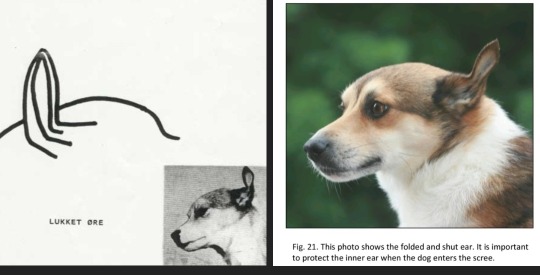
The standard:
Ears: Triangular ears of medium size, broad at the base, carried erect and very mobile. The cartilage of the ear lobe has the faculty of being able to retract itself so that the ear folds itself and flops in a specific manner, either backwards or in right angle upwards, so as to close the auditory passage.
Compendium addition:
The ears of the Lundehund have a unique muscle that enables them to fold and close the ears when entering the burrows, thus protecting them against dirt and moisture. The turning and folding of the ears probably also is help in locating the birds.

The standard:
Forelimbs: Moderately angulated. Forearm: Straight.
Forefeet: Oval shaped, turning slightly outwards, with at least six toes of which five must rest on the ground. Eight pads on each foot. The two inner toes, formed respectively by 3 and 2 phalanges and endowed with a ligamentary and muscular system, make the foot look solid.
Compendium addition:
Very flexible and elastic shoulder muscles. The Lundehund has joints that allow the forelimbs to extend at nearly 90 degrees from the body, but this must NEVER be demonstrated in the ring! The forefeet turn slightly outwards to give room for the extra toes.
The Norwegian Lundehund is a polydactyl. Instead of the normal 4 digits, the Lundehund normally has 6 digits, all fully formed, jointed and muscled, with tendons going up the inside of the leg, partly responsible for its wide front gait. Some specimen may have more, others less than 6 digits per foot, but less than 6 on front feet should lead to downgrading. The extra toes help the dog climbing up and down crevices in screes and cliffs.
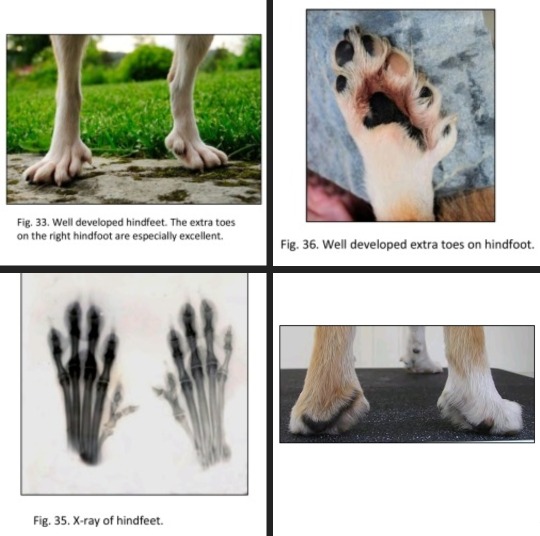
The standard:
Hindfeet : Oval shaped, turned slightly outwards, with at least six toes - four of which must rest on the ground. Seven pads on each foot, the one in the middle, the most important one by its size, being attached to the inner pads corresponding to the two inner toes. When the dog is standing up on a flat surface, the weight of the body must be evenly distributed on the pads.
Compendium comment:
More than 6 digits is not a fault. 5 digits are acceptable on the hind feet. The extra toes on the hind feet are normally less developed than those on the forelegs and variations from the ideal, both regarding number and placement, should not be penalized.
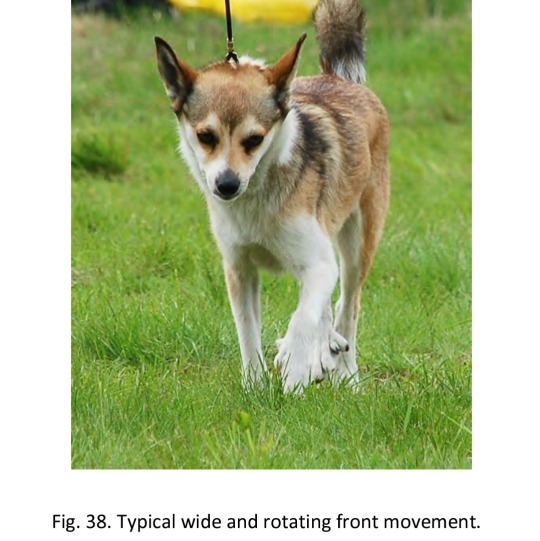
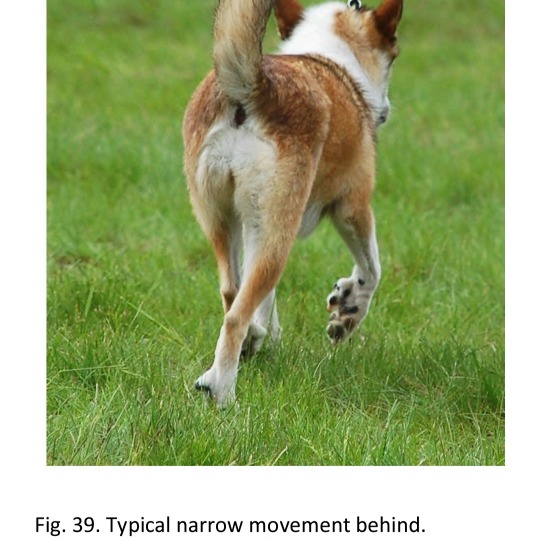
The standard:
Gait/Movement: Light and elastic. An external rotary action of the forelegs and somewhat close action behind is characteristic of the breed.
Compendium comment:
In judging the movements of the Lundehund, one must consider that this dog is built to climb efficiently up and down steep cliffs and screes. The extra pads on both fore- and hind paws must then touch the surface to aid the dog in climbing. The extra toes help getting a grip, both in ascent and descent. The wide front with extra flexibility enables climbing safely up and down crevices, as the forelegs can grip at a 90 degrees angle to the body. On flat surfaces, the Lundehund will show typical rotating front movements, due to tendons and muscles from the extra digits on the inside of the legs. Hind movements are narrow.
#the norway of today is a wealthy country with very high living standards and such#and thats had an effect on people's personal connection to this part of culture. obviously#but just decades ago we were very poor farmers and fishermen whose animals were integral our ways of life#modernization moved slowly in norway#my mother grew up in the 50s - family of sheep farmers - before the popularization of the border collie#sleeping on straw mattresses and the only dogs people had were little buhund thingies whose ancestry had never been tracked#but who were buhunds because they were the right general shape and filled the niche#so for a lot of us this history is still very close.#but theres also a touchy facet of this where norwegians are not the indigenous population and the strengthening of the#norwegian national identity came at the cost of sámi and kven culture.#a lot of norwegian national romanticism sees us as oppressed by southern powers. we lost our language and a lot of history#but when we gained independence we turned around and became oppressors.#so yknow. dont want to talk about this but not mention that.#especially in the area where the lundehund originated and i wouldnt be surprised if anti-northern sentiment was part of why the lundehund#was not the focus of widespread preservation efforts earlier#but now im just rambling
995 notes
·
View notes
Text
anyway remember that sweden colonized and/or ruled finland for 600 years and that both countries still occupy and exploit sámi land.
edit: just to make clear in this post since people apparently read this in a way i didn’t mean it (probably my fault, i sometimes assume things are implicitly understood when they are not, and i wrote this in the middle of the night) my intention was NOT to imply that sweden should be excluded from esc due to its historical occupation of finland. that part was a comment on the relation between the countries and was a reaction to the posts i kept seeing pitting sweden and finland against each other in a way i found very interesting because history informs how people relate to each other. there have been more intelligent additions on that topic in othe reblogs of this post. what i did mean to say about exclusion from esc however is that sweden and also finland (and norway) should be excluded on the basis of their continued occupation and exploitation of sámi land (and also culture for tourism reasons), and that’s why i emphasized sápmi specifically in the reblog.
#fuck eurovision fuck sweden AND fuck finland but fuck sweden much more.#p#esc#eurovision#sápmi#sweden
2K notes
·
View notes
Text
Since my big Languages and Linguistics MEGA folder post is approaching 200k notes (wow) I am celebrating with some highlights from my collection:
Africa: over 90 languages so far. The Swahili and Amharic resources are pretty decent so far and I'm constantly on the lookout for more languages and more resources.
The Americas: over 100 languages of North America and over 80 languages of Central and South America and the Caribbean. Check out the different varieties for Quechua and my Navajo followers are invited to check out the selection of Navajo books, some of which are apparently rare to come by in print.
Ancient and Medieval Languages: "only" 18 languages so far but I'm pretty pleased with the selection of Latin and Old/Middle English books.
Asia: over 130 languages and I want to highlight the diversity of 16 Arabic dialects covered.
Australia: over 40 languages so far.
Constructed Languages: over a dozen languages, including Hamlet in the original Klingon.
Creoles: two dozen languages and some materials on creole linguistics.
Europe: over 60 languages. I want to highlight the generous donations I have received, including but not limited to Aragonese, Catalan, Occitan and 6 Sámi languages. I also want to highlight the Spanish literature section and a growing collection of World Englishes.
Eurasia: over 25 languages that were classified as Eurasian to avoid discussions whether they belong in Europe or Asia. If you can't find a language in either folder it might be there.
History, Culture, Science etc: Everything not language related but interesting, including a collection of "very short introductions", a growing collection of queer and gender studies books, a lot on horror and monsters, a varied history section (with a hidden compartment of the Aubreyad books ssshhhh), and small collections from everything like ethnobotany to travel guides.
Jewish Languages: 8 languages, a pretty extensive selection of Yiddish textbooks, grammars, dictionaries and literature, as well as several books on Jewish religion, culture and history.
Linguistics: 15 folders and a little bit of everything, including pop linguistics for people who want to get started. You can also find a lot of the books I used during my linguistics degree in several folders, especially the sociolinguistics one.
Literature: I have a collection of classic and modern classic literature, poetry and short stories, with a focus on the over 140 poetry collections from around the world so far.
Polynesia, Micronesia, Melanesia: over 40 languages and I want to highlight the collection for Māori, Cook Islands Māori and Moriori.
Programming Languages: Not often included in these lists but I got some for you (roughly 5)
Sign Languages: over 30 languages and books on sign language histories and Deaf cultures. I want to highlight especially the book on Martha's Vineyard Sign Language and the biography of Laura Redden Searing.
Translation Studies: Everything a translation student needs with a growing audiovisual translation collection
And the best news: the folders are still being updated regularly!
2K notes
·
View notes
Text





In Norway’s far northern territory of Finnmark, nearly 5% of the population had been tried for witchcraft by the end of the 17th century. “The Perpetual Flame” tells the story of Norway’s Vardø witch trials and their legacy.
#magick#magic#witchcraft#sorcery#witchtrials#witch trials#history#early modern#enchantedpodcast#history podcast#podcast#norway#vardø#sámi#Norse
2 notes
·
View notes
Note
Also eda and lilith being pale doesnt make them less "indigenous" or mean that their ancestors like evelyn must have appeared different racially! There are plenty of people considered indigenous who might have very pale skin or appear "white" in the way that western countries have tried to define thet in the last few hundred years! Not to bring up the irish again, but there are people who would certainly be considered white and maybe the palest people on earth like me, but are "indigenous" in the sense rhey havent been removed from their ancestral homelands on the far western coast. Esp the Traveller people who are culturslly considered indigenous.
People like the Sámi who are "racially white" are indigenous to Norway and Sweden, and maintain cultural traditions local to the area and highly distinct from Christianised people of those countries.
There are also the turkic peoples all across russia, siberia and northern asia. Certainly indigenous and maintaining cultural lifestyles far removed from the Slavics of the western areas.
This isnt an attack or like. Wahwahwahwqqhh youre not woke 😡 but its more like indigenous is best considered as cultural and not racial because any race can be indigenous, there isnt a special quality that makes a race More Indigenous, its about cultural traditions and ways of living that are better criteria for classification.
In my country, "indigenous" is very racialised in meaning just like in the USA but it's sort of like. Something thats sort of specific by country to country and wont apply well to a fantasy world without those histories and classification systems.

YOURE SO CORRECT DONT WORRY I was mostly bringing up them being pale because I know a lot of people associate them being soooo pale with them being white BUT YKWIM YOURE NOT OUTWOKING ME CISJFNKVNVKDNFJV I actually thought this was super interesting!!!
69 notes
·
View notes